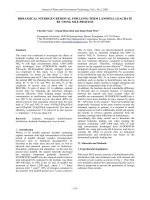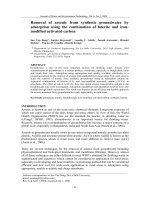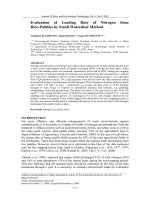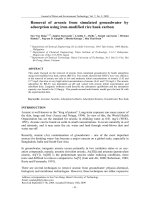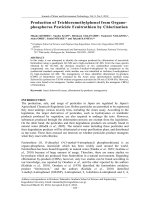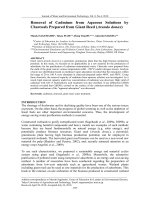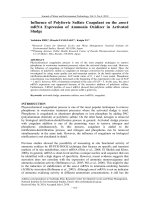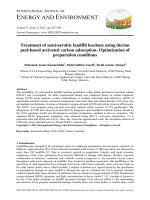Struvite Precipitation of Ammonia from Landfill Leachate
Bạn đang xem bản rút gọn của tài liệu. Xem và tải ngay bản đầy đủ của tài liệu tại đây (13.88 MB, 175 trang )
Struvite Precipitation of Ammonia from Landfill Leachate
By
Chi Zhang
A thesis submitted
Under the supervision of Dr. Majid Sartaj
A thesis submitted in partial fulfilment of the requirements for the degree of
Master of Applied Science
In
Environmental Engineering
Department of Civil Engineering
University of Ottawa
Ottawa-Carleton Institute for Environmental Engineering
Ottawa, Ontario, Canada
© Chi Zhang, Ottawa, Canada, 2016
ABSTRACT
The application of struvite (magnesium ammonium phosphate,!MgNH& PO& ∙ 6H+ O)
precipitation and its recycling use for the purpose of ammonia removal from both
synthetic solutions and landfill leachate were investigated in this study. The results
demonstrated that chemical precipitation by struvite formation is efficient for ammonia
removal from aqueous solutions. In addition, by recycling the thermal residue of struvite,
continuously removing ammonia can technically be achieved.
In the struvite precipitation, ammonia removal significantly depended on the pH and
chemical molar ratios of NH&, :!Mg +, :!PO./
& . For synthetic solution (TAN=1,000 mg/L),
remarkable TAN removal efficiency of over 98% has been reported when the molar ratio
of NH&, :!Mg +, :!PO./
equals 1.0:1.2:1.2, 1.0:1.3:1.3, 1.0:1.3:1.4 and 1.0:1.5:1.5 at
&
optimum pH 9. The optimum combinations of reagents applied in landfill leachate
(TAN=1,878 mg/L) were!NH&, :!Mg +, :!PO./
=1.0:1.3:1.3, 1.0:1.4:1.3, 1.0:1.5:1.4 and
&
1.0:1.5:1.5 at optimum pH 9.5, all of which displayed excellent TAN removal
efficiencies of over 99%. Response surface method (RSM) helped to analyze the data and
optimize the results.
The struvite pyrolysate provided best performance of removing ammonia in both
simulated wastewater and landfill leachate at a dosage of 60 g/L, when struvite was
previously heated at 105
by oven for 2.5 h. In the recycling phase, the struvite
pyrolysate resulting from NaOH-mediated pyrolysis was more effective at continuously
treating ammonia synthetic solution than was direct heating, with an initial mode of
87.4% at the beginning to 75.1% in the fifth round and direct heating of struvite from
80.9% in the first cycle and 60.6% in the final cycle. The struvite pyrolysate formed by
NaOH-mediated pyrolysis performed with greater ability to continuously eliminate
ammonia from landfill leachate (97.2% removal at the beginning and 72.3% in the fifth
round), than did directly heated struvite (98.4% in the first cycle and 81.3% in the final
cycle). Additionally, microwave irradiation could also dissociate struvite, which
subsequently demonstrated moderate TAN removal in recycling phases.
!
ii!
ACKNOWLEGEMENTS
First of all, I would like to express my deepest gratitude to my academic supervisor,
Dr. Majid Sartaj, who has always been professional, patient and supportive through this
long journey of mine to the completion of my master degree. Without his guidance and
support, I would not have the opportunity to achieve this, not to mention the great
suggestions on my research work. I will always be grateful that I have the experience of
studying and working with him.
In addition, special thanks to Yuanhao Ding, Sainan Dong and Akin, who has been
selfless and helpful during my research. I learnt a lot from them. Scholarship provided by
Solid Waste Association of North America (SWANA) is also appreciated.
Finally, I would also like to thank my family, my girlfriend Amber and my friends
for their unfailing support and understanding from the very beginning to the last minute
of my work in these two years. They made me feel less lonely throughout this long and
windy journey; I dedicate this thesis to them.
!
iii!
Table of Contents
ABSTRACT........................................................................................................................ ii
ACKNOWLEGEMENTS .................................................................................................. iii
Table of Contents ............................................................................................................... iv
Lists of Figures ................................................................................................................. vii
Lists of Tables ..................................................................................................................... x
List of Abbreviations ........................................................................................................ xii
CHAPTER I ........................................................................................................................ 1
1.1 Background ............................................................................................................... 1
1.2 Objectives ................................................................................................................. 2
1.3 Thesis Layout ............................................................................................................ 3
References ....................................................................................................................... 4
CHAPTER II....................................................................................................................... 6
2.1 Municipal Solid Waste Landfilling ........................................................................... 6
2.2 Landfill Leachate ...................................................................................................... 8
2.3 Ammonia................................................................................................................. 13
2.3.1 Characteristics of Ammonia ............................................................................ 13
2.3.2 Sources and concentrations of Ammonia ........................................................ 14
2.3.3 Ammonia inhibition and toxicity ..................................................................... 16
2.4 Treatments for ammonia removal ........................................................................... 18
2.4.1 Biological treatment ......................................................................................... 19
2.4.2 Air stripping ..................................................................................................... 22
2.4.3 Adsorption by activated carbon ....................................................................... 24
2.4.4 Ion-exchange by Zeolite .................................................................................. 26
2.4.5 Membrane processes ........................................................................................ 28
2.4.6 Chemical precipitation ..................................................................................... 31
!
iv!
2.5 Summary ................................................................................................................. 42
References ..................................................................................................................... 44
CHAPTER III ................................................................................................................... 64
3.1 Materials and Equipment ........................................................................................ 64
3.1.1 Synthetic Ammonia Solution and Landfill Leachate ....................................... 64
3.1.2 Chemical Reagents........................................................................................... 65
3.1.3 Lists of Equipment ........................................................................................... 65
3.1.4 Analytical Techniques ..................................................................................... 67
3.2 Methodology ........................................................................................................... 69
3.3 Response surface methodology............................................................................... 73
CHAPTER IV ................................................................................................................... 75
Abstract ......................................................................................................................... 75
4.1 Introduction ............................................................................................................. 77
4.2 Materials and Methodology .................................................................................... 80
4.3 Results and Discussion ........................................................................................... 85
4.3.1 Effect of pH...................................................................................................... 85
4.3.2 Effect of molar ratio ......................................................................................... 87
4.3.3 Response surface optimization and statistical analysis .................................... 91
4.3.4 Thermal treatment of struvite by oven heating ................................................ 95
4.3.4.1 Effect of heating time................................................................................ 98
4.3.4.2 Effect of heating temperature.................................................................... 99
4.3.4.3 Effect of struvite pyrolysate dosage ........................................................ 100
4.3.4.4 Effect of pH............................................................................................. 101
4.3.4.5 Effect of multiple struvite pyrolysate resue cycles ................................. 102
4.3.5 Struvite decomposition by microwave irradiation ......................................... 104
4.4 Conclusion ............................................................................................................ 107
References ................................................................................................................... 108
CHAPTER V .................................................................................................................. 117
Abstract ....................................................................................................................... 117
!
v!
5.1 Introduction ........................................................................................................... 118
5.2 Materials and Methodology .................................................................................. 121
5.3 Results and Discussion ......................................................................................... 127
5.3.1 Effect of pH.................................................................................................... 127
5.3.2 Effect of molar ratio ....................................................................................... 128
5.3.3 Response surface optimization and statistical analysis .................................. 134
5.3.4 Thermal treatment of struvite by oven heating .............................................. 138
5.3.4.1 Effect of heating time.............................................................................. 141
5.3.4.2 Effect of heating temperature.................................................................. 142
5.3.4.3 Effect of dosage ...................................................................................... 143
5.3.4.4 Effect of pH............................................................................................. 144
5.3.4.5 Effect of multiple cycles of treated struvite reuse .................................. 145
5.3.5 Struvite decomposition by microwave irradiation ......................................... 147
5.4 Conclusion ............................................................................................................ 149
References ................................................................................................................... 151
CHAPTER VI ................................................................................................................. 160
6.1 Conclusions ........................................................................................................... 160
6.2 Future work ........................................................................................................... 161
APPENDIX ..................................................................................................................... 162
!
vi!
Lists of Figures
Fig. 2. 1 Landfill Leachate (Fernandes et al. 2015) ............................................................ 8
Fig. 2. 2 Free ammonia percentage in solution at 20, 35 and 55
and varying pH
(Adapted from Fernandes et al., 2012) ..................................................................... 14
Fig. 2. 3 Nitrogen transformations in landfill environment .............................................. 20
Fig. 2. 4 Struvite crystal produced from lagoon wastewater (Westerman, 2009) ............ 31
Fig. 2. 5 TGA-DTA curve of struvite (Adapted from Chen et al., 2015) ......................... 41
Fig. 3. 1 CEM Microwave Accelerated Reaction System (MARS 5)………….………..66
Fig. 3. 2 PRECISION mechanical convection oven ......................................................... 66
Fig. 3. 3 Filtration kit ........................................................................................................ 67
Fig. 3. 4 Dry struvite generated from synthetic solution (left) and landfill leachate (right)
................................................................................................................................... 67
Fig. 3. 5 HACH TNTplus832 Ammonia vial ................................................................... 68
Fig. 3. 6 HACH DR6000 spectrophotometer.................................................................... 69
Fig. 3. 7 Experimental Flow Chart.................................................................................... 73
Fig. 4. 1 Experimental Flow Chart (Synthetic Solution)………………………………...83
Fig. 4. 2 Effect of pH on TAN removal by struvite precipitation
.0
(NH&, :!Mg +, :!PO& =1.0:1.0:1.0 and 1.0:1.2:1.2) (at 1,000 mg TAN/L) ................... 86
Fig. 4. 3 Effect of the individual variation of magnesium/phosphate levels on the TAN
removal efficiency from synthetic solution (at 1,000 mg TAN/L and pH of 9) ....... 88
.0
Fig. 4. 4 Effect of the different molar ratios of NH&, :!Mg +, :!PO& on the TAN removal
efficiency (at 1,000 mg TAN/L and pH of 9) ............................................................ 90
Fig. 4. 5 RSM model of TAN removal by struvite formation at n(P:N) = 1.25 ................ 93
Fig. 4. 6 RSM model of TAN removal by struvite formation at n(M:N) = 1.0 ................ 94
Fig. 4. 7 RSM model of TAN removal by struvite formation at pH = 8 ........................... 94
Fig. 4. 8 Thermogravimetric analysis (TGA)-Differential thermal analysis (DTA) curve
of struvite (Adapted from Chen et al., 2015) ............................................................ 97
Fig. 4. 9 TAN removal efficiency by the use of struvite pyrolysate generated at different
!
vii!
heating times at 105 ̊C (at 1,000 mg TAN/L and pH of 9) ....................................... 98
Fig. 4. 10 TAN removal efficiency by the use of struvite pyrolysate generated at different
pyrolysis temperatures for a heating duration of 2.5h (at 1,000 mg TAN/L and pH of
9) ............................................................................................................................. 100
Fig. 4. 11 Effect of the dosage of struvite pyrolysate (heating time=2.5h and heating
temperature=105
) on the removal of TAN from synthetic solution (at 1,000 mg
TAN/L and pH of 9) ................................................................................................ 101
Fig. 4. 12 Effect of pH on TAN removal from synthetic solution with 40 g/L of struvite
pyrolysate heated for 2.5 h at 105
(at 1,000 mg TAN/L) .................................. 102
Fig. 4. 13 Repeat use of the struvite pyrolysate (heating time=2.5h and heating
temperature=105
) by direct heating and NaOH-mediated heating as a precipitator
in TAN removal from synthetic solution (1,000 mg TAN/L, pH = 9, struvite
pyrolysate dosage = 60 g/L).................................................................................... 104
Fig. 4. 14 TAN removal efficiency in synthetic solution by the use of struvite pyrolysate
generated at different heating time by microwave irradiation (pH = 9, pyrolysate
dosage = 60 g/L) ..................................................................................................... 106
Fig. 4. 15 Repeated use of the struvite pyrolysate from microwave irradiation with two
different power outputs, as a precipitator in TAN removal from synthetic solution
(pH = 9, pyrolysate dosage = 60g/L, heating time= 30 min) .................................. 107
Fig. 5. 1 Experimental Flow Chart (Landfill Leachate)
125
Fig. 5. 2 Effect of pH on TAN removal from landfill leachate by struvite precipitation
.0
NH&, :!Mg +, :!PO& =1.0: 1.0:1.0) (at 1,878 mg TAN/L) ........................................... 128
Fig. 5. 3 Effect of the individual variation of magnesium/phosphate levels on the TAN
removal efficiency from landfill leachate (at 1,878 mg TAN/L and pH of 9)........ 130
.0
Fig. 5. 4 Effect of the different molar ratios of NH&, :!Mg +, :!PO& on the TAN removal
from leachate (at 1,878 mg TAN/L and pH 9)........................................................ 133
Fig. 5. 5 RSM model of TAN removal by struvite formation at n(P:N) = 1.25 .............. 136
Fig. 5. 6 RSM model of TAN removal by struvite formation at n(M:N) = 1.0 .............. 137
Fig. 5. 7 RSM model of TAN removal by struvite formation at pH = 9 ........................ 137
Fig. 5. 8 Thermogravimetric analysis (TGA)-Differential thermal analysis (DTA) curve
!
viii!
of struvite (Adapted from Chen et al. 2015) ........................................................... 140
Fig. 5. 9 TAN removal efficiency in landfill leachate by the use of struvite pyrolysate
generated at different heating times at 105 ̊C (at 1,878 mg TAN/L and pH of 9) .. 141
Fig. 5. 10 TAN removal from landfill leachate by the use of struvite pyrolysate generated
at different pyrolysis temperatures for a heating duration of 2.5h (at 1,878 mg
TAN/L and pH of 9) ............................................................................................... 142
Fig. 5. 11 Effect of the dosage of struvite pyrolysate (heating time=2.5h and heating
temperature=105
) on the removal of TAN from landfill leachate (at 1,878 mg
TAN/L and pH of 9) ............................................................................................... 143
Fig. 5. 12 Effect of pH on TAN removal from landfill leachate with 40 g/L of struvite
pyrolysate heated for 2.5 h at 105
(at 1,878 mg TAN/L) .................................. 144
Fig. 5. 13 Repeat use of the struvite pyrolysate (heating time=2.5h and heating
temperature=105
) by direct heating and NaOH-mediated heating as a precipitator
in TAN removal from landfill leachate (1,878 mg TAN/L, pH = 9, struvite
pyrolysate dosage = 60 g/L).................................................................................... 146
Fig. 5. 14 TAN removal efficiency in landfill leachate by the use of struvite pyrolysate
generated at different heating time by microwave irradiation (pH = 9.5, pyrolysate
dosage = 60 g/L) ..................................................................................................... 148
Fig. 5. 15 Repeated use of the struvite pyrolysate from microwave irradiation with two
different power outputs, as a precipitator in TAN removal from landfill leachate (pH
= 9, pyrolysate dosage = 60g/L) ............................................................................. 149
!
ix!
Lists of Tables
Table 2. 1 Potential advantages and disadvantages of three types of bioreactor landfills
(Adapted from Omar and Rohani, 2015) .................................................................... 7
Table 2. 2 Initial screening of leachate (adapted from El-Fadel et al., 2013) ..................... 9
Table 2. 3 Regulatory limits of leachate contaminants (TAN, phosphorus, COD and
BOD5) (Adapted from Mukherjee et al. 2014) ......................................................... 11
Table 2. 4 Classification of landfill leachate according to age (Adapted from Abbas et al.,
2009; Mukherjee et al., 2014; Ren et al., 2010) ........................................................ 12
Table 2. 5 Ammonia concentration and pH in different landfill sites (Adapted from
Renou et al., 2008) .................................................................................................... 15
Table 2. 6 Effect of ammonia concentration on anaerobic digestion process .................. 17
Table 2. 7 Comparison of conventional and novel ammonia nitrogen removal processes21
Table 2. 8 Treatment performance of air stripping for removal of ammonia nitrogen
(Adapted from Kurniawan et al., 2006a) .................................................................. 24
Table 2. 9 Activated carbon characteristics (Adapted from Aziz et al., 2004) ................. 25
Table 2. 10 Lists of researches for the landfill leachate treatment via activated carbon
adsorption process during the last 15 years (Adapted from Foo and Hameed, 2009)
................................................................................................................................... 26
Table 2. 11 Removal of NH. and COD using NF/ RO (Adapted from Kurniawan et al.,
2006) ......................................................................................................................... 30
Table 2. 12 Magnesium ammonium phosphate precipitation for ammonia removal from
wastewater (Adapted from Guo, 2010; Li et al., 2012; Rahman et al., 2014) .......... 35
Table 3. 1 Leachate characteristics....................................................................................64
Table 3. 2 Lists of equipment ........................................................................................... 65
.0
Table 3. 3 Different combinations of NH&, :!Mg +, :!PO& .................................................. 70
.0
Table 4. 1 Different combinations of NH&, :!Mg +, :!PO& ………………………………..81
Table 4. 2 Analysis of variance (ANOVA) for RSM full quadratic model parameters .... 92
Table 4. 3 Analysis of variance (ANOVA) for RSM reduced quadratic model parameters
!
x!
................................................................................................................................... 93
Table 5. 1 Leachate characteristics……………………………………………………..122
.0
Table 5. 2 Different combinations of NH&, :!Mg +, :!PO& ................................................ 123
Table 5. 3 Analysis of variance (ANOVA) for RSM full quadratic model parameters .. 135
Table 5. 4 Analysis of variance (ANOVA) for RSM reduced quadratic model parameters
................................................................................................................................. 136
!
xi!
List of Abbreviations
AC: activated carbon;
AD: anaerobic digestion;
ANOVA: analysis of variance
AOXs: adsorbable organic halogens;
AS: activated sludge;
BOD: biochemical oxygen demand;
CEPA: Canadian Environmental Protection Agency
CI: confidence interval;
COD: chemical oxygen demand;
DF: degree of freedom;
DW: distilled water;
FA: free ammonia;
GAC: granular activated carbon
IER: ion-exchange resin;
LFG: landfill gas;
MAP: magnesium ammonium phosphate;
MBR: membrane bioreactor
MF: microfiltration;
MLSS: mixed liquor suspended solids;
MS: mean square
MWS: municipal solid waste;
MW: microwave;
NF: nanofiltration;
N:M:P=NH&, : Mg +, : PO./
& ;
PAC: powdered activated carbon;
PAHs: polyarmatic hydrocarbons;
PCBs: polychlorinated biphenyls;
!
xii!
RO: reverse osmosis;
RSM: response surface methodology;
SBR: sequencing batch reactor;
SS: suspended solids
TAN: total ammonia nitrogen;
TKN: total Kjeldahl nitrogen;
UASB: up-flow anaerobic sludge blanket;
UF: ultrafiltration ;
USEPA: United State Environmental Protection Agency
VFA: volatile fatty acid ;
VSS: volatile suspended solid
!
xiii!
CHAPTER I
INTRODUCTION
1.1 Background
Ammonia is recognized as one of the dominant inorganic contaminants in natural
aquatic systems (Ip, 2010). Wastewater from municipal effluent discharges, metal
industry, run-off from agricultural activities, petroleum and food-processing industries
and landfill leachate contribute as the main source of ammonia in natural water
environment (Metcalf and Eddy, 2003). In aqueous state, total ammonia (TAN) exists in
two forms: the un-ionized ammonia (NH. ); and ionized ammonia (NH&, ). The balance of
these two types of ammonia in the aqueous phase depends on pH and temperature (Nair
et al., 2014).
As containing one of the necessary elements (nitrogen, N) of life, low concentration
of ammonia (50 to 200 mg/L), to some certain degree, can benefit the organisms’ growth
(Rajagopal et al., 2013). However, the presence of excessive ammonia can lead to
accelerated eutrophication of lakes and rivers, dissolved oxygen depletion and fish
toxicity in receiving water bodies (Du et al., 2005). The toxicity of ammonia can be
illustrated as the inhibition to microorganisms due to un-ionized ammonia (Chen et al.,
2008). Ammonia concentration is reported to be up to 13,000 mg/L in municipal landfill
leachate (Renou et al., 2008), while the range from 1,500 to 5,000 mg/L is reported as the
toxic levels resulting in inhibition (Lee et al. 2000; Liu et al., 2012). United States
Environmental Protection Agency (USEPA) fresh water quality criteria for ammonia are
17 mg TAN/L (acute) and 1.9 mg TAN/L (chronic) under the circumstance of pH at 7
and temperature at 20
(Environmental Protection Agency, 2013). Canadian
Environmental Protection Agency (CEPA) added ammonia to the list of toxic substances
in 1999 (Environment Canada, 2001) and set the maximum concentration of un-ionized
ammonia in the effluent (15±1
!
): 1.25 mg/L as NH. – N (Canada Gazette, 2012).
1!
Different treatment methods for ammonia removal from aqueous environment
include conventional processes such as biological nitrification/denitrification, air
stripping, membrane filtration and ion-exchange (Ferraz et al., 2013; Hasar et al., 2009;
Malekian et al., 2011; Sri et al., 2012). Developing feasible techniques and optimizing
current methods for removing ammonia from highly contaminated wastewater as
treatment or pre-treatment at reasonable cost has been one of the central research topic in
water and wastewater in recent decades.
1.2 Objectives
The main aim of this project is to investigate the feasibility of the application of
struvite (magnesium ammonium phosphate, MAP, MgNH& PO& ∙ 6H+ O) precipitation for
ammonia removal from the synthetic solution and municipal landfill leachate with high
ammonium concentrations; thereby recovering struvite possible recycling use. First phase
is to investigate the optimum operational parameters for ammonia removal from synthetic
aqueous solution and landfill leahcate using chemical precipitation of struvite formation.
Second phase is to study the performance of struvite pyrolysate on continuous ammonia
removal from aqueous solutions. Objectives of this research include:
!! To investigate ammonia removal by studying the effect of pH and molar ratio of
NH&, :!Mg +, :!PO./
by the addition of magnesium and phosphate source
&
!! To evaluate and optimize the results by the analysis of response surface
methodology (RSM)
!! To determine the optimum operation conditions (heating time, heating temperature,
reaction pH, effect of struvite pyrolysate dosage, effect of NaOH addition in
pyrolysis) for the regenerating and recycling of thermal-pretreated struvite to
remove ammonia from liquid systems
!! Study the application of microwave irradiation in dissociating struvite and the
possible recycled use of struvite pyrolysate
!
2!
1.3 Thesis Layout
This thesis is presented in the form of technical papers with six main chapters.
Chapter I contains the background, introduction, the statement of the problem, the
objectives of the research and the thesis organization. Chapter II is the literature review
of the presence of high concentration ammonia in aqueous solution, especially in landfill
leachate, and the current treatment approaches available. Chapter III presents the
materials, equipment and methodology used in this study. Chapter IV is the first technical
paper entitled: “Assessment and Optimization of Struvite Precipitation for Ammonia
Removal from Aqueous Solution”. Chapter V is the second technical paper entitled:
“Assessment and Optimization of Struvite Precipitation of Ammonia from Landfill
Leachate”. Chapter VI summarizes the conclusions of this study and the future work
recommendations. Taking into account that this thesis is prepared in a paper-based
format, there could be some repeated information appearing in different chapters.
!
3!
References
Chen, Ye, Jay J. Cheng, and Kurt S. Creamer. 2008. “Inhibition of Anaerobic Digestion
Process: A Review.” Bioresource Technology :4044–64.
Du, Qi, Shijun Liu, Zhonghong Cao, and Yuqiu Wang. 2005. “Ammonia Removal from
Aqueous Solution Using Natural Chinese Clinoptilolite.” Separation and Purification
Technology 44(3):229–34.
U. S. Environmental Protection Agency. 2013. “Aquatic Life Ambient Water Quality
Criteria for Ammonia – Freshwater (EPA-822-R-13-001).” (April):255.
Ferraz, Fernanda M., Jurandyr Povinelli, and Eny Maria Vieira. 2013. “Ammonia Removal
from Landfill Leachate by Air Stripping and Absorption.” Environmental Technology
34(15):2317–26.
Hasar, Halil, Unsal, S. A., Ipek, U., Karatas, S., Cınar, O., Yaman, C., & Kınacı, C
2009. “Stripping/flocculation/membrane Bioreactor/reverse Osmosis Treatment of
Municipal Landfill Leachate.” Journal of Hazardous Materials 171:309–17.
Ip, Yuen. 2010. “Ammonia Production, Excretion, Toxicity, and Defense in Fish: A
Review.” Frontiers in Physiology 1(October):1–20.
Lee, S. M., J. Y. Jung, and Y. C. Chung. 2000. “Measurement of Ammonia Inhibition of
Microbial
Activity
in
Biological
Wastewater
Treatment
Process
Using
Dehydrogenase Assay.” Biotechnology Letters 22(12):991–94.
Liu, Jianyong, Luo, J., Zhou, J., Liu, Q., Qian, G., & Xu, Z. P.
2012. “Inhibitory Effect of High-Strength Ammonia Nitrogen on Bio-Treatment of
Landfill Leachate Using EGSB Reactor under Mesophilic and Atmospheric
Conditions.” Bioresource Technology 113:239–43.
Malekian, Raheleh, Abedi-Koupai, J., Eslamian, S. S., Mousavi, S. F., Abbaspour
2011. “Ion-Exchange Process for Ammonium Removal and Release Using Natural
Iranian Zeolite.” Applied Clay Science 51(3):323–29.
Metcalf, E. and H. Eddy. 2003. Wastewater Engineering: Treatment and Reuse.
Nair, Arjun, Majid Sartaj, Kevin Kennedy, and Nuno Mg Coelho. 2014. “Enhancing
Biogas Production from Anaerobic Biodegradation of the Organic Fraction of
Municipal Solid Waste through Leachate Blending and Recirculation.” Waste
!
4!
management & research": the journal of the International Solid Wastes and Public
Cleansing Association, ISWA 32(10):939–46.
Rajagopal, Rajinikanth, Daniel I. Massé, and Gursharan Singh. 2013. “A Critical Review
on Inhibition of Anaerobic Digestion Process by Excess Ammonia.” Bioresource
Technology 143:632–41.
Renou, S., J. G. Givaudan, S. Poulain, F. Dirassouyan, and P. Moulin. 2008. “Landfill
Leachate Treatment: Review and Opportunity.” Journal of Hazardous Materials
150(3):468–93.
Sri Shalini, S. and Kurian Joseph. 2012. “Nitrogen Management in Landfill Leachate:
Application of SHARON, ANAMMOX and Combined SHARON-ANAMMOX
Process.” Waste Management 32(12):2385–2400.
!
5!
CHAPTER II
LITERATURE REVIEW
2.1 Municipal Solid Waste Landfilling
Solid wastes management treatments, include waste sorting, recycling, composting,
incineration and landfilling. Landfilling remains the main method for municipal solid
waste (MSW) management in many countries and areas worldwide (Vigneron et al.,
2007; Kheradmand et al., 2010) . Landfilling of MSW is a very important method of the
waste management system and up to 75% of such waste collected worldwide is disposed
of in landfill sites (Abbas et al., 2009; Guo et al., 2010). A MSW landfill is regarded as a
treatment facility whose objective is to obtain a residual solid of a “final storage quality”,
one which does not adversely affect the environment for long periods (Lubberding et al.,
2012). Historically, landfills were operated in the “dry-tomb” method but now they are
switching to bioreactor landfilling approach as it has many advantages over the
conventional landfilling. They include: (1) it increases the effective density of waste and
therefore increases the capacity of landfills, (2) it increases the potential for energy
production and recovery of landfill gas, (3) in-situ treatment by recirculation of leachate
in the bioreactors leads to reduced operational expenses, (4) it accelerates decompositions
of waste with the effect of shortening the monitoring period and thereby reducing the
overall cost, (5) it enhances the sustainability allowing possible reuse of the land
(Fernandes et al., 2015; Mukherjee et al., 2014; Omar and Rohani, 2015; Warith, 2002).
Currently, three types of bioreactor landfills (anaerobic, aerobic and semi-aerobic) are
being widely employed and their potential advantages and disadvantages are displayed in
Table 2.1 (Omar and Rohani, 2015). Solids wastes in the MSW landfill lead to two major
environmental impacts. First, leachate, defined as the harmful liquid waste generated by
water that has percolated through the landfilled waste material, which could migrate into
groundwater; Second, gaseous emissions (Landfill gas or LGS) produced by the
!
6!
fermentation of organic fractions, a source of air pollution and one of main contributing
source for global warming (Ahmed and Lan, 2012).
Table 2. 1 Potential advantages and disadvantages of three types of bioreactor landfills
(Adapted from Omar and Rohani, 2015)
Advantages
Anaerobic
Disadvantages
(1) LFG has high methane
(1) High VFA concentration can
concentration which can be used
leach harmful constituents
(2) Decreased waste stabilization
(2) Relatively high levels of
times
ammonia in leachate
(3) Relatively low cost
(3) Production of hydrogen sulfide
(4) In-situ treatment of leachate
(1) Decreased waste stabilization
times
(2) Little to no methane
production decreases green house
gas emissions
Aerobic
(3) In-situ treatment of leachate
(1) High cost for aeration
(2) Produced air that can cause
flammable/explosive mixture
(3) Unknown gases may be
produced
(4) Removal of moisture by air
stripping
(5)Little to no ammonia
production
Semi-aerobic
(1) Decreased waste stabilization
(1) Unknown gases may be
times
produced
(2) Little methane production
(2) Produced air that can cause
decreases GHG emissions
flammable/explosive mixture
(3) In-situ treatment of leachate
(4) Relatively low cost
!
7!
2.2 Landfill Leachate
As landfill leachate extracts several pollutants as it moves through the waste
material, it is a very complex wastewater (Fernandes et al., 2015). Landfill leachate is a
dark colored liquid (Figure 2.1), with a strong smell, which carries a high organic and
inorganic load (Peng, 2013). The composition of leachate is complex and variable since it
is influenced by surrounding conditions, features and composition of residual deposit,
leachate age, operational manner of the landfill site and the dynamics of the
decomposition process within the landfill cells and etc. (Aziz, 2004; El-Fadel et al., 2002;
Thomas et al., 2009). According to a study by Paxéus (2000), more than two hundred
individual organic compounds and classes of compounds were detected and some of them
are extremely toxic to life. The understanding of leachate characteristics at a specific
landfill site is the most crucial matter for designing management strategy for both old and
new landfills (Rafizul and Alamgir, 2012).
Fig. 2. 1 Landfill Leachate (Fernandes et al. 2015)
Leachate composition can be characterized by several basic parameters: chemical
oxygen demand (COD), biological oxygen demand (BOD), its associated ratio
(BOD/COD), suspended solids (SS), total Kjeldahl nitrogen (TKN) and ammonia
nitrogen (NH. – N), heavy metals, etc. These parameters vary significantly from one
landfill to another. An initial screening of leachate were conducted by El-Fadel et al.
!
8!
(2013) displaying thirty-nine typical different parameters researchers commonly
measured.
Table 2. 2 Initial screening of leachate (adapted from El-Fadel et al., 2013)
Parameter
Unit
pH
pH units at 25 °C
EC
!
µ Simens/cm at
25°C
Fresh
Fresh
Evaporation
Leachate 1
Leachate 2
Pond
7.26
7.91
7.56
38,200
50,400
45,500
Turbidity
NTU
175
175
250
Apparent color
PtCo units
13,550
14,300
9,250
Total alkalinity
mg/L as CaCO3
15,460
16,380
16,220
TDS
mg/L
19,100
25,200
22,800
TSS
mg/L
635
928
798
Total phosphorus
mg/L P
39.5
25
27
COD
mg/L
17,760
16,520
9,520
BOD
mg/L
10,935
9,720
4,890
Ammonia
mg/L NH3
3,600
1,800
4,700
Total nitrogen
mg/L N
4,200
2,200
5,250
Chlorides
mg/L Cl-
7,800
14,700
9,300
ortho-Phosphates
mg/L PO43-
25.5
11
28
Total hardness
mg/L as CaCO3
2,450
2,150
810
Fecal coliforms
CFU/50 ml
ND c
ND
ND
Total coliforms
CFU/50 ml
ND
ND
ND
Li
ppm
0.012
0.233
0.0215
Be
ppm
<0.002
<0.002
<0.002
Ti
ppm
0.707
0.526
0.934
V
ppm
0.258
0.323
0.361
Cr
ppm
0.461
0.685
0.481
9!
Mn
ppm
0.193
0.329
0.234
Co
ppm
0.112
0.119
0.116
Ni
ppm
0.481
0.75
0.541
Cu
ppm
0.007
0.039
0.031
As
ppm
0.05
0.176
0.104
Se
ppm
0.042
0.086
0.029
Sr
ppm
0.516
0.675
0.438
Mo
ppm
0.027
0.116
0.035
Ag
ppm
<0.002
<0.002
<0.002
Cd
ppm
0.008
0.003
0.009
Sb
ppm
0.004
0.029
0.013
Ba
ppm
0.779
0.135
0.235
W
ppm
0.015
0.021
0.024
TI
ppm
<0.002
<0.002
<0.002
Pb
ppm
0.007
0.023
0.018
U
ppm
<0.002
<0.002
<0.002
Zn
ppm
0.05
0.007
0.053
Landfill leachate can cause enormous harm to ecosystem when released into the
environment without suitable treatment (Mukherjee et al., 2014). In order to minimize its
impact, regulatory limits of various leachate components (TAN, phosphorus, COD,
BOD5) in different countries are set, as summarized in Table 2.4. It can be observed that
stricter limits are enforced in developed countries vs. developing countries. The stringent
discharge limits for leachate demands advanced technologies and equipment that may
lead to high operation and maintenance costs.
!
10!
Table 2. 3 Regulatory limits of leachate contaminants (TAN, phosphorus, COD and
BOD5) (Adapted from Mukherjee et al. 2014)
Parameter/Country
NH3-N
PO4-P
COD
BOD5
(mg/L)
(mg/L)
(mg/L)
(mg/L)
Hong Kong
5
25
200
800
France
5
25
120
30
South Korea
50
-
50
-
Poland
10
-
125
30
Australia
0.5
0.1
-
10
China
15
0.5 (TP)
100
-
Bangladesh
50
-
200
50
India
50
-
250
30
Previous studies have found that average COD value lies in the range of 10,000 mg/L
to 30,000 mg/L with approximately 100 mg/L reported as lowest and over 70,000 mg/L
as the highest (Aziz et al., 2004; Duggan, 2005; Thomas et al., 2009). Some leachates
have been reported to have neutral pH while others tend to lean to alkaline values over
7.5 (Abbas et al., 2009). The leachate has unique characteristics, such as high
concentrations of ammonia nitrogen (NH. and NH&, ), high COD, low potential for
biological degradation, and the presence of metals and other organic and inorganic
substances that confer a high toxicity to this type of waste, and hinder its treatment
(Camargo et al., 2014). Among the leachate constituents, ammonia nitrogen is one of
particular concern because its concentration could reach high levels (800 to 5,210 mg/L)
(Ferraz et al., 2013) due to a process called ammonification (Berge et al., 2005). The
leachate generated in landfills varies in strength and composition depending on several
factors, but the most significant factor is the age of the landfill (Peng et al., 2008;
Kheradman et al., 2010). Leachate types can be generally divided into young leachate and
old (mature) leachate (Gao et al., 2014). Compared to old leachate, young leachate has
extremely high concentrations of ammonia, VFAs and COD with a relatively low pH
(Nair et al., 2014). Detailed characteristics of the mature and young leachate are
!
11!
presented in Table 2.4. Young leachate have low molecular weight organic compounds
characterized by linear chains, which are substituted through oxygenated functional
groups such as carboxyl and alcoholic groups (Calace et al., 2001). Old leachate have
organic compounds with a wide range of molecular weight fractions having complex
structures with N, S, and O containing functional groups (Calace et al., 2001).
Additionally, the concentration and biodegradability of leachate usually decrease with its
age (El-Fadel et al., 2002). Ammonia concentration in leachate is also an important
parameter to consider for the safe closure of landfill sites (Lubberding et al., 2012).
Table 2. 4 Classification of landfill leachate according to age (Adapted from Abbas et al.,
2009; Mukherjee et al., 2014; Ren et al., 2010)
Young (0-5)
Old (>20)
Landfilling phase
Aerobic and acidic
Age (year)
<1
1-5
>5
pH
<6.5
6.5-7.5
>7.5
TDS (mg/L)
10,000-25,000
2,000-10,000
<1,000
BOD5 (mg/L)
10,000-25,000
50-1,000
<50
COD (mg/L)
>10,000
3,000-10,000
<1,000
BOD5/COD
0.5-1.0
0.1-0.5
<0.1
TOC / COD
<0.3
0.3-0.5
>0.5
NH3-N (mg/L)
500-1,500
300-500
<30
100-200
400-600
<50
Heavey metals (mg/L)
>2
<2
<2
Cl- (mg/L)
1,000-3,000
100-2,000
<100
Sulfate (mg/L)
500-2,000
50-1,000
<50
Phosphorus (mg/L)
100-300
10-100
<10
Ca (mg/L)
2,000-4,000
300-2,000
<300
Na, K (mg/L)
2,000-4,000
100-1,500
<100
Mg, Fe (mg/L)
500-1,500
50-1,000
<100
Kjeldahl
nitrogen(mg/L)
!
Medium (5-20)
12!
Methanogenic
